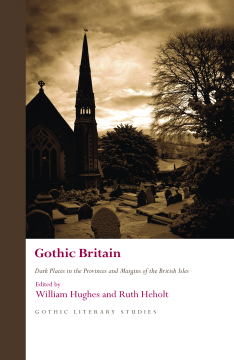
Additional Information
Book Details
Abstract
Gothic Britain is the first collection of essays to consider how the Gothic responds to, and is informed by, the British regional experience. Acknowledging how the so-called United Kingdom has historically been divided on nationalistic lines, the twelve original essays in this volume interrogate the interplay of ideas and generic innovations generated in the spaces between the nominal kingdom and its component nations and, innovatively, within those national spaces. Concentrating upon fictions depicting England, Scotland and Wales specifically, Gothic Britain comprehends the generic possibilities of the urban and the rural, of the historical and the contemporary, of the metropolis and the rural settlement – as well as exploring uniquely the fluid space that is the act of travel itself. Reading the textuality of some two hundred years of national and regional identity, Gothic Britain interrogates how the genre has depicted and questioned the natural and built environments of the island of Britain.
Table of Contents
| Section Title | Page | Action | Price |
|---|---|---|---|
| Cover | i | ||
| Title Page | iv | ||
| Copyright | v | ||
| Dedication | vi | ||
| Contents | viii | ||
| Acknowledgements | x | ||
| Notes on Contributors | xii | ||
| Introduction: The Uncanny Space of Regionality: Gothic Beyond the Metropolis: William Hughes | 1 | ||
| Part I: Re-imagined Gothic Landscapes: Folklore, Nostalgia and History | 25 | ||
| 1: 'Dark, and cold, and rugged is the North': Regionalism, Folklore and Elizabeth Gaskell's 'Northern' Gothic: Catherine Spooner | 27 | ||
| 2: The Gothic Child and the West Yorkshire Moors: The Deconstruction of Space in Jeremy Dyson's The Haunted Book: Chloé Germaine Buckley | 44 | ||
| 3: 'Spook Business': Hall Caine and the Moment of Manx Gothic: Richard Storer | 63 | ||
| 4: 'All those ancient stories that had their dark souls located in woods': Rural Gothic, Scottish Folklore and Postmodern Conundrums in James Robertson's The Testament of Gideon Mack: Gioia Angeletti | 81 | ||
| Part II: Unnatural Gothic Spaces | 99 | ||
| 5: Entering the Darkness: Robert Aickman and the Regions: Timothy Jones | 101 | ||
| 6: University Gothic, c.1880–1910: Minna Vuohelainen | 118 | ||
| 7: Vampiristic Museums and Library Gothic: Holly-Gale Millette | 137 | ||
| Part III: Border Crossings and the Threat of Invasion | 159 | ||
| 8: Lifting the Veil: Ambivalence, Allegory and the Scottish Gothic in Walter Scott’s Union Fiction: Jamil Mustafa | 161 | ||
| 9: Cosmopolis Fever: Regionalism and Disease Ecology in Mary Shelley’s The Last Man: Ben Richardson | 179 | ||
| 10: The Hammer House of Cornish Horror: The Inversion of Imperial Gothic in The Plague of the Zombies and The Reptile: Ruth Heholt | 195 | ||
| 11: Gothic Immigration: Kentish Gothic and the Borders of Britishness: Sarah Ilott | 211 | ||
| Bibliography | 233 | ||
| Index | 249 | ||
| Back Cover | 254 |
